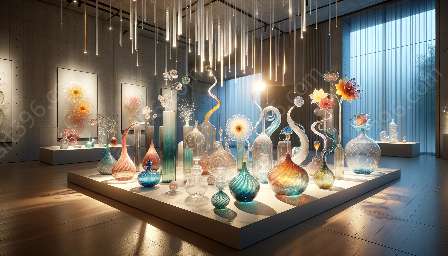Glass sculpting has a rich history, with several significant landmarks and influential figures who have shaped the art form. From its origins in ancient civilizations to modern innovations, glass sculpting has captivated artists and audiences alike. Let's explore the evolution of this art form and the key figures who have made lasting contributions.
Early Beginnings of Glass Sculpting
The history of glass sculpting dates back thousands of years, with evidence of early glassmaking found in Mesopotamia and Ancient Egypt. These ancient civilizations used glass to create intricate vessels and ornaments, laying the foundation for glass art as we know it today.
Historic Landmark: Roman Artistry
One of the most influential periods in the history of glass sculpting is the Roman era, where glass artisans developed advanced techniques, such as mold-blowing and cameo glass, to create stunning works of art. The Portland Vase, a renowned Roman glass vessel, remains an iconic example of Roman glass sculpting and continues to inspire modern artists.
The Renaissance and Beyond
During the Renaissance, glass sculpting experienced a resurgence in Europe, with artists such as Antonio Neri and Giacomo Briano contributing to the development of new glassmaking methods. The era also saw the establishment of glassmaking centers in Murano, Italy, which became renowned for their exquisite glass artworks.
Influential Figure: Dale Chihuly
Fast-forward to the modern age, and one cannot discuss glass sculpting without mentioning Dale Chihuly. His pioneering work in the studio glass movement and iconic installations have propelled glass art into the realm of contemporary art, garnering widespread acclaim and appreciation.
Modern Innovations and Contemporary Artists
Today, glass sculpting continues to evolve, with artists pushing the boundaries of the medium through experimentation with form, color, and techniques. Figures such as Lino Tagliapietra and Toots Zynsky have made significant contributions to the contemporary glass art scene, showcasing the diversity and versatility of glass as a sculptural material.
Historic Landmark: Corning Museum of Glass
An essential landmark for glass sculpting aficionados is the Corning Museum of Glass, which houses a vast collection of historical and contemporary glass artworks, providing invaluable insight into the evolution of the craft.
Conclusion
From its ancient origins to its modern-day innovations, the world of glass sculpting is a testament to the enduring allure of this art form. The historical landmarks and influential figures in glass sculpting have shaped its trajectory, inspiring generations of artists to explore the boundless possibilities of working with this mesmerizing material.

